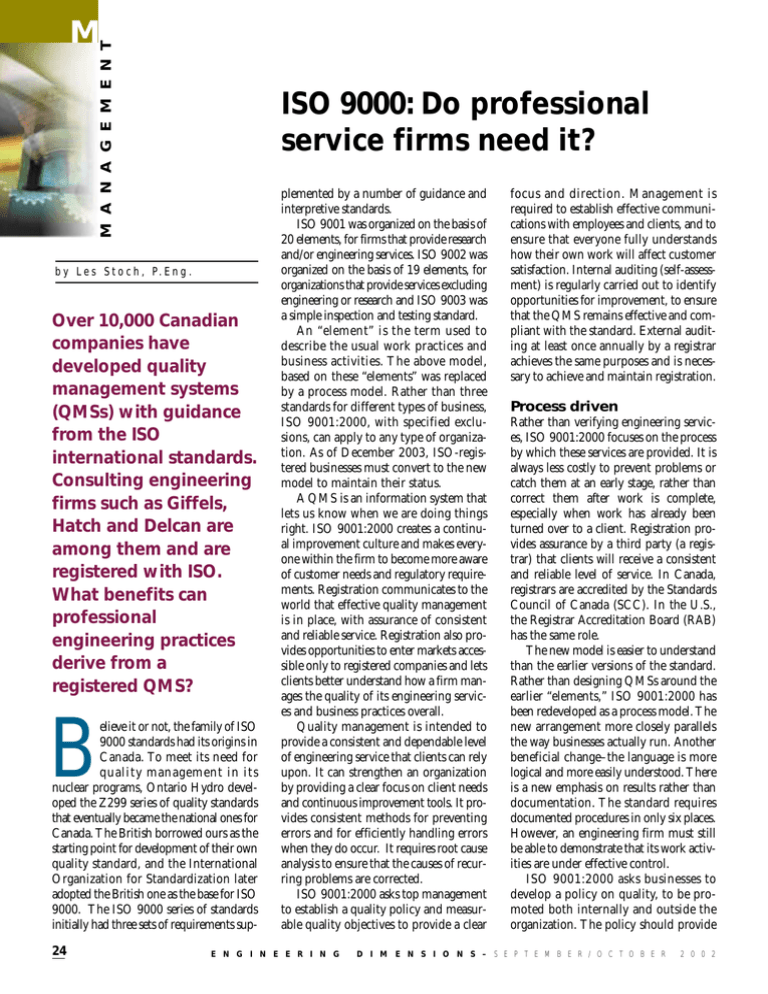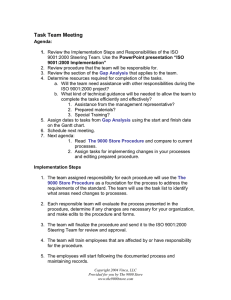M ISO 9000: Do professional service firms need it?
advertisement

M A N A G E M E N T M ISO 9000: Do professional service firms need it? b y L e s S t o c h , P. E n g . Over 10,000 Canadian companies have developed quality management systems (QMSs) with guidance from the ISO international standards. Consulting engineering firms such as Giffels, Hatch and Delcan are among them and are registered with ISO. What benefits can professional engineering practices derive from a registered QMS? B elieve it or not, the family of ISO 9000 standards had its origins in Canada. To meet its need for quality management in its nuclear programs, Ontario Hydro developed the Z299 series of quality standards that eventually became the national ones for Canada. The British borrowed ours as the starting point for development of their own quality standard, and the International Organization for Standardization later adopted the British one as the base for ISO 9000. The ISO 9000 series of standards initially had three sets of requirements sup24 plemented by a number of guidance and interpretive standards. ISO 9001 was organized on the basis of 20 elements, for firms that provide research and/or engineering services. ISO 9002 was organized on the basis of 19 elements, for organizations that provide services excluding engineering or research and ISO 9003 was a simple inspection and testing standard. An “element” is the term used to describe the usual work practices and business activities. The above model, based on these “elements” was replaced by a process model. Rather than three standards for different types of business, ISO 9001:2000, with specified exclusions, can apply to any type of organization. As of December 2003, ISO-registered businesses must convert to the new model to maintain their status. A QMS is an information system that lets us know when we are doing things right. ISO 9001:2000 creates a continual improvement culture and makes everyone within the firm to become more aware of customer needs and regulatory requirements. Registration communicates to the world that effective quality management is in place, with assurance of consistent and reliable service. Registration also provides opportunities to enter markets accessible only to registered companies and lets clients better understand how a firm manages the quality of its engineering services and business practices overall. Quality management is intended to provide a consistent and dependable level of engineering service that clients can rely upon. It can strengthen an organization by providing a clear focus on client needs and continuous improvement tools. It provides consistent methods for preventing errors and for efficiently handling errors when they do occur. It requires root cause analysis to ensure that the causes of recurring problems are corrected. ISO 9001:2000 asks top management to establish a quality policy and measurable quality objectives to provide a clear E N G I N E E R I N G focus and direction. Management is required to establish effective communications with employees and clients, and to ensure that everyone fully understands how their own work will affect customer satisfaction. Internal auditing (self-assessment) is regularly carried out to identify opportunities for improvement, to ensure that the QMS remains effective and compliant with the standard. External auditing at least once annually by a registrar achieves the same purposes and is necessary to achieve and maintain registration. Process driven Rather than verifying engineering services, ISO 9001:2000 focuses on the process by which these services are provided. It is always less costly to prevent problems or catch them at an early stage, rather than correct them after work is complete, especially when work has already been turned over to a client. Registration provides assurance by a third party (a registrar) that clients will receive a consistent and reliable level of service. In Canada, registrars are accredited by the Standards Council of Canada (SCC). In the U.S., the Registrar Accreditation Board (RAB) has the same role. The new model is easier to understand than the earlier versions of the standard. Rather than designing QMSs around the earlier “elements,” ISO 9001:2000 has been redeveloped as a process model. The new arrangement more closely parallels the way businesses actually run. Another beneficial change–the language is more logical and more easily understood. There is a new emphasis on results rather than documentation. The standard requires documented procedures in only six places. However, an engineering firm must still be able to demonstrate that its work activities are under effective control. ISO 9001:2000 asks businesses to develop a policy on quality, to be promoted both internally and outside the organization. The policy should provide D I M E N S I O N S – S E P T E M B E R / O C T O B E R 2 0 0 2 a commitment to meeting customer requirements and continual improvement, become the framework for establishing and reviewing quality objectives. It should also be periodically reviewed for continuing suitability. Higher still One of the ways by which engineering practices can continue to improve their performance is by setting and achieving measurable objectives for quality. Firms should set new goals as they achieve earlier ones or as the business evolves. Measurement ensures that we know how well we are doing and can take any actions necessary to achieve the desired goals. A member of the management team should be designated as a management representative, with responsibility to establish and maintain the quality system, and to report on its performance. The management representative is also responsible for creating quality awareness within the E N G I N E E R I N G organization and communicating the importance of meeting customer requirements, with a key role in creating effective staff communications. Proper training is a key requirement for the achievement of consistent and reliable service quality. ISO 9001:2000 includes obligations to ensure that people are sufficiently qualified, to evaluate training effectiveness and to ensure that people are aware of the importance of their personal contributions toward client satisfaction. Effective client communications are of utmost importance for a successful engineering firm. Clients are gained or lost based on their perceptions. It follows that everyone whose job involves communications, should be aware of his or her responsibility as a professional. People should receive awareness training when they have responsibility for activities such as client contracts, marketing and sales, handling customer feedback, problems and complaints and providing service information. D I M E N S I O N S – S E P T E M B E R / O C T O B E R Today, many large corporations and government departments demand registration as a business prerequisite of their suppliers. It follows that registration can provide access to more clients. Many companies seek registration for that very reason. But more importantly, ISO 9000 can provide a firm with a clearer focus on client needs and legal requirements as well as better efficiency, consistency and a reduction in rework. Getting started It’s a good idea to initially assess your present quality management procedures against the ISO 9001:2000 standard. This reminds everyone of what is already in place and gives you a clearer idea of what still needs to be done. Selecting the registrar Shop around for a compatible registrar who understands your business, is recognized by your customers and treats you like a customer. An agreement will be 2 0 0 2 25 M drawn up detailing the rights and obligations of both parties. Most registration contracts are for three years. Registration tells the world that you maintain an effective QMS. Organizing your team Your project will be most successful when responsibilities are delegated to qualified people and management must take on a leading role. Senior management must establish your firm’s quality policy and objectives for quality, and ensure that they are effectively communicated and understood. A management representative should be appointed and given the responsibility and authority to develop your QMS, maintain and report to management on its effectiveness and to communicate the importance of satisfying customer requirements. Developing your QMS Decide on which locations, activities, etc. will fall within the scope of your QMS. Decide which activities are not a part of your business. Develop the necessary documentation (when not already in place) describing your QMS along with any exclusions from the standard, your organization’s quality policy and measurable objectives for quality. Develop procedures where they are required by the standard or otherwise needed to show that you are in control of your work processes. Implement the QMS and train people on any new procedures. Establish internal auditing to ensure your system remains current and effective. Registration Your registrar will initially ask to review a copy of your quality documentation. When accepted, the registrar will arrange for an audit to find out whether your QMS is effectively implemented and complies with the standard. The auditors will also look for evidence that your organization is following your own procedures. Once registered, the registrar will carry out annual or semi-annual surveillance audits during the registration period to confirm that you are still doing what you say you are doing. Registration costs vary with the size of each firm and number of locations. It pays to shop around before contracting with a registrar. Consultant fees will also vary with the size of the firm and number of locations. Of course the greatest expense is always the work involved in setting up and maintaining the QMS. Nevertheless, a well-developed and maintained QMS should always provide offsetting revenues over and above these costs. Further information can be obtained from The International Organization for Standardization (www.iso.ch); The Standards Council of Canada (www.scc.ca); and Industry Canada (strategis.ic.gc.ca). Les Stoch, P.Eng., consults on ISO registration and is based in Mississauga. 26 E N G I N E E R I N G D I M E N S I O N S – S E P T E M B E R / O C T O B E R 2 0 0 2





